Prepare to impress with the ultimate boneless prime rib roast, a culinary masterpiece delivering a harmonious blend of salty, sweet, and savory notes with an incredibly tender, melt-in-your-mouth texture. This guide unveils my step-by-step process and a foolproof reverse searing method, guaranteeing a show-stopping main course that will delight every guest at your table. Forget the stress of holiday cooking; with these techniques, a perfect prime rib is within your reach.

Pin this recipe to save for later!
Pin It
Why This Reverse-Seared Boneless Prime Rib Will Be Your New Favorite Recipe
Even if you’re new to cooking prime rib, cast aside your worries! This comprehensive guide will empower you to roast an impeccably cooked prime rib, boasting a uniform rosy interior and an exquisite, golden-brown crispy crust. This dish is not just a meal; it’s an experience, ideal for elevating holiday parties, grand family gatherings, or any occasion deserving of something truly spectacular.
- Unfailingly Perfect: The innovative reverse searing method, combined with a gentle, low-and-slow cooking process, is the secret weapon behind this recipe’s consistent perfection. It minimizes the risk of overcooking, ensuring every inch of the roast is evenly cooked to your desired doneness, with a stunning edge-to-edge pink hue.
- Explosion of Flavor: Each succulent bite is a symphony of sweet, savory, and salty flavors. The carefully selected seasonings and tenderizing agents penetrate deep into the meat, creating a rich, complex taste profile. The juicy texture will leave your guests craving more, making this a truly memorable dish.
- Effortlessly Crowd-Pleasing: A single boneless prime rib roast is substantial enough to comfortably serve 10-12 people, making it an excellent choice for larger groups. Its impressive presentation and delectable taste consistently earn rave reviews from friends and family, solidifying its status as a celebratory centerpiece.
To complete your restaurant-quality dining experience right in the comfort of your home, perfectly pair your magnificent prime rib roast with complementary side dishes. Consider serving creamy roasted garlic mashed potatoes, vibrant honey-glazed roasted carrots, and warm, fluffy homemade dinner rolls.
Key Ingredients for an Unforgettable Prime Rib
Crafting the perfect prime rib begins with selecting high-quality ingredients and understanding how each contributes to the final masterpiece. Here’s a closer look at the stars of this recipe:
- Boneless Prime Rib: This premium cut, also known as a standing rib roast, rolled rib roast, or ribeye roast, hails from the primal rib section of the cow. For this recipe, I recommend a 6-pound boneless roast, which is ideal for feeding a crowd. Choosing a boneless cut simplifies carving and often cooks more evenly.
- Coarse Kosher Salt: Essential for the dry brining process, coarse kosher salt helps draw out moisture, leading to a crispier exterior and a more intensely flavored interior. It’s the foundation of a great crust.
- Montreal Steak Seasoning: This robust blend typically includes black pepper, garlic, onion, coriander, and dill, adding a deep, savory, and aromatic flavor profile that perfectly complements beef. It’s crucial for building that incredible golden crust.
- Minced Garlic: Freshly minced garlic cloves offer the most pungent and authentic flavor, infusing the roast with a delicious aroma and taste. If fresh isn’t an option, good quality pre-minced garlic can be a convenient substitute. Feel free to increase the amount if you’re a true garlic enthusiast!
- Olive Oil: More than just a lubricant, olive oil acts as a binder, ensuring the seasonings adhere perfectly to the meat’s surface. It also contributes to the browning process, helping to create a beautiful crust while locking in essential moisture and flavor. Avocado oil is a suitable alternative with a high smoke point.
- Brown Sugar: A touch of brown sugar introduces a delightful sweetness that balances the savory and salty elements of the seasoning blend. It also aids in caramelization during the searing phase, contributing to a rich, dark crust.
- Worcestershire Sauce: This fermented condiment is a secret weapon, adding a distinctive salty, smoky, and umami depth to the roast. Its slightly acidic nature also helps tenderize the beef, enhancing its melt-in-your-mouth quality.
Expert Tips for Choosing the Perfect Boneless Prime Rib Roast
Selecting the right cut of meat is the first critical step towards achieving prime rib perfection. When you’re at the butcher or grocery store, keep these key factors in mind to ensure you bring home the best possible roast:
- Abundant Marbling: This is arguably the most important factor. Marbling refers to the fine streaks of white fat interspersed throughout the red muscle tissue. As the beef cooks, this intramuscular fat renders, basting the meat from within. This process is what makes prime rib incredibly juicy, tender, and intensely flavorful. Look for a roast with generous, even marbling.
- A Well-Defined Fat Cap: On the exterior of the roast, you want to see a distinct, even layer of white fat, known as the fat cap. This protective layer slowly melts as the roast cooks, seeping into the meat and contributing significantly to its overall tenderness, moisture, and rich flavor. Avoid roasts with very thin or patchy fat caps.
- Uniform Size and Shape: Opt for a roast that is relatively even in thickness from end to end. A uniform shape ensures that the entire roast cooks at a consistent rate, preventing some parts from being overcooked while others remain undercooked. Larger roasts are often easier to cook evenly than smaller, oddly shaped ones, as they are less susceptible to rapid temperature changes. Don’t hesitate to ask your butcher to trim or tie the roast for a more consistent shape if needed.
Mastering the Art: How to Cook the Best Boneless Prime Rib Roast
1. Prepare Your Prime Rib for Optimal Flavor and Texture
- Dry Brine Overnight: Begin by placing the unwrapped prime rib on a tray. Generously season it all over with coarse kosher salt. Refrigerate the roast overnight (up to 24 hours). This crucial dry brining step draws out moisture from the surface, creating an ideal environment for a magnificent crispy crust, and allows the salt to penetrate deeply, seasoning the meat from within.
- Achieve Room Temperature: Approximately two hours before you plan to begin roasting, remove the prime rib from the refrigerator and let it sit on the kitchen counter. Bringing the roast to room temperature ensures more even cooking, preventing the exterior from overcooking before the center reaches the desired doneness.
- Craft the Flavorful Rub: In a small bowl, combine the olive oil, Montreal steak seasoning, brown sugar, Worcestershire sauce, and minced garlic. Mix these ingredients thoroughly until you have a smooth, well-blended paste.
- Apply the Seasoning Evenly: With clean hands, liberally spread the prepared seasoning mixture over the entire surface of the prime rib. Ensure every side is well-coated to maximize flavor penetration and crust development.
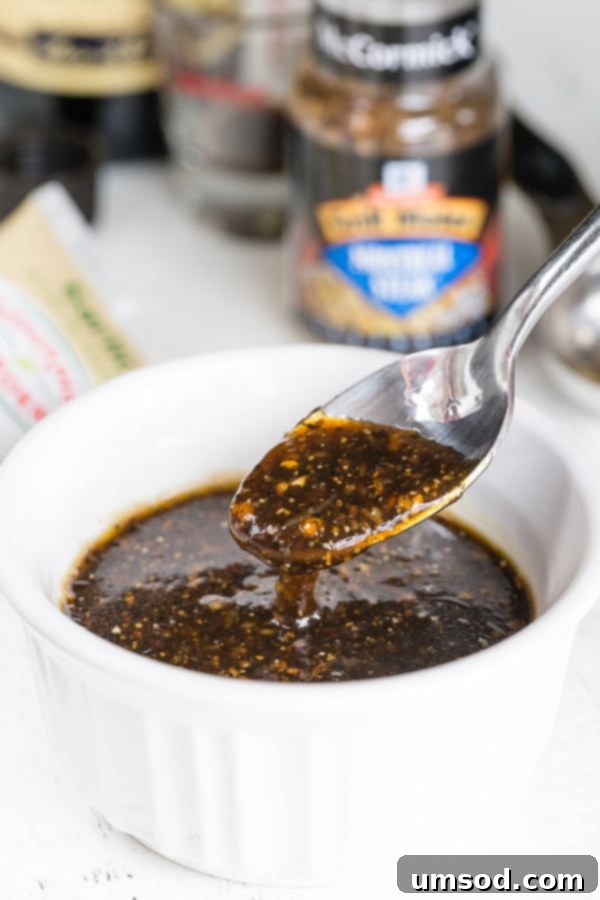
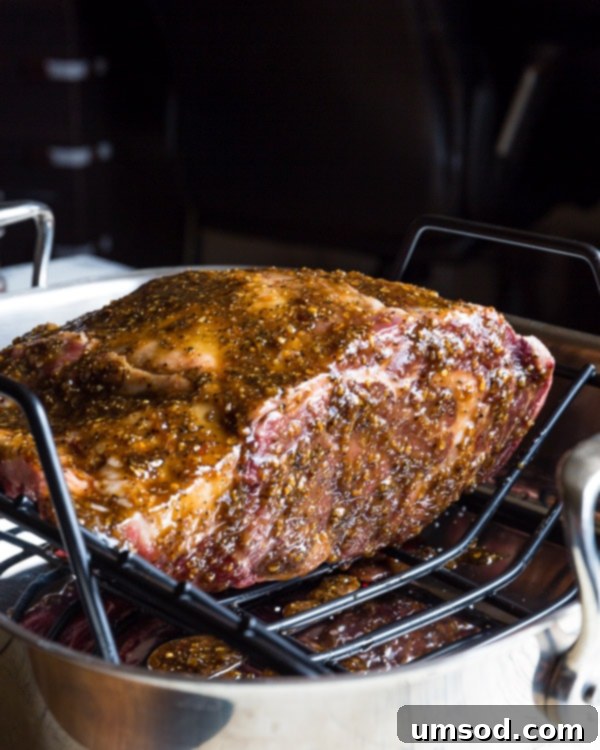
2. The Low-and-Slow Roast for Perfect Internal Temperature
- Preheat Oven: Set your oven temperature to a low 200°F (95°C). This low temperature is fundamental to the reverse searing method, allowing the roast to cook gently and evenly throughout.
- Position the Roast: Place the generously seasoned prime rib into a sturdy roasting pan, ensuring the fat side is facing up. (For an excellent cooking experience, I highly recommend this particular roaster).
- Slow Roast to Perfection: Roast the prime rib for approximately 3.5 to 4 hours. The exact cooking time will vary based on your oven and the roast’s specific size, so the internal temperature is your most reliable indicator.
- Critical Resting Period: Once your roast reaches the desired internal temperature, carefully remove it from the oven. Tent it loosely with aluminum foil and allow it to rest undisturbed for at least 30 minutes. This vital step enables the natural juices within the meat to redistribute evenly, ensuring every slice is incredibly juicy and tender. Skipping this step can result in a dry roast.
Always Use a Reliable Meat Thermometer!
Never attempt to guess the doneness of a prime rib, as overcooking this magnificent (and often expensive) cut would be a culinary tragedy. Instead, invest in and use a high-quality meat thermometer, such as a Thermapen ONE, to precisely monitor the internal temperature. Aim for 120°F (49°C) for a perfect medium-rare, or 130°F (54°C) for a medium doneness before the final sear.
3. The Grand Finale: Searing for an Irresistible Crust
- Crank Up the Heat: While the prime rib is resting, significantly increase your oven temperature to a blazing 500°F (260°C). This high heat is crucial for achieving that signature crispy crust.
- Sear for a Golden Crust: Just 10 minutes before you plan to serve, return the uncovered prime rib to the super-hot oven. Allow it to cook for approximately 6-10 minutes, or until its exterior transforms into a beautiful deep brown and develops an enticing crispness. Keep a close eye on it to prevent burning.
- Final Rest, Then Serve: After searing, remove the roast from the oven for a final brief rest of 10-15 minutes. This allows the intense heat from the sear to settle. Then, slice against the grain and present your magnificent prime rib roast to your eager guests!
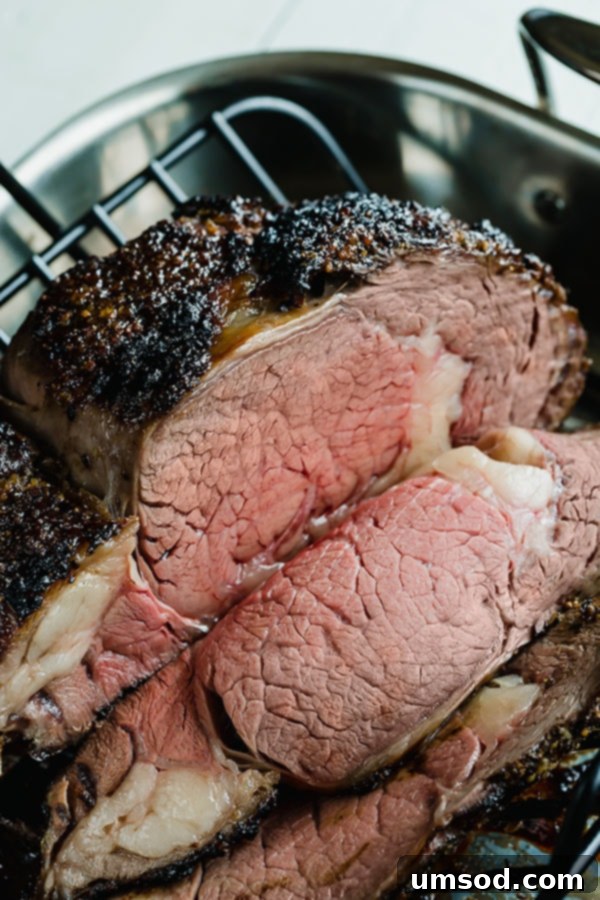

Essential Tips for Prime Rib Perfection
Achieving a truly spectacular prime rib involves a few key practices. Adhering to these tips will elevate your roasting skills and guarantee a perfect outcome every single time:
- Embrace the Reverse Sear: This isn’t just a suggestion; it’s the cornerstone of this recipe’s success. Cooking the roast initially at a low temperature ensures uniform internal doneness with a minimal gray band, while the subsequent high-temperature blast creates that coveted, flavorful, crispy crust. This dual-temperature approach is the secret to maximum flavor and juiciness.
- Your Meat Thermometer is Your Best Friend: For an investment as significant as a prime rib, accuracy is paramount. A reliable meat thermometer is non-negotiable to prevent overcooking or undercooking. Insert it into the thickest part of the roast, avoiding bone, to get an accurate reading. This precision guarantees your roast reaches your desired doneness perfectly.
- Respect the Rest: It’s incredibly tempting to carve into that aromatic roast immediately, but patience is a virtue here. Allowing ample resting time (at least 30 minutes after the initial roast, and 10-15 minutes after searing) is crucial. Resting permits the muscle fibers to relax and the internal juices to redistribute throughout the meat, resulting in a supremely tender and moist roast. Carving too soon will cause those precious juices to run out, leaving you with a dry and less flavorful outcome.
- Slice Against the Grain: When it’s time to carve, pay attention to the direction of the meat fibers (the grain). Always slice perpendicular to these natural lines. Cutting against the grain shortens the muscle fibers, making each slice incredibly tender and easy to chew, enhancing the overall eating experience.
- Monitor and Adjust Cooking Time: Every oven is unique, and roast sizes can vary. While approximate cooking times are provided, they serve as a guideline. Trust your meat thermometer more than the clock. Continuously monitor the internal temperature and be prepared to adjust cooking times as needed to achieve your desired doneness. Refer to the cooking chart for precise temperature targets.
- Consider Making Au Jus: Don’t let those delicious pan drippings go to waste! After roasting, you can easily turn them into a rich, savory au jus to serve alongside your prime rib. Simply skim off excess fat, deglaze the pan with a little beef broth or red wine, and reduce it to create a flavorful sauce.
Make-Ahead Tips for Stress-Free Entertaining
Planning for a special meal often involves managing many tasks. The good news is that this boneless prime rib roast recipe is not only suitable for make-ahead preparation, but it actually benefits from it, reducing stress on the day of your event!
- Salt and Refrigerate in Advance: For the best results and to truly maximize the flavor and texture of your prime rib, salt the roast generously and refrigerate it, unwrapped, up to one full day (24 hours) in advance. This allows for a thorough dry brining process, which is key to developing that incredible crust and deep flavor.
- Bring to Room Temperature: On the day of cooking, remove the salted roast from the refrigerator at least two hours before you plan to put it in the oven. Allowing it to come to room temperature ensures a more even and predictable cook, preventing the thermal shock that can occur if cold meat is placed directly into a hot oven. Once it’s at room temperature, proceed with applying the rest of the seasoning and follow the roasting instructions.
Failing to perform the initial salting and refrigeration step can lead to a less desirable outcome, as the roast won’t develop the prized crispy crust we’re aiming for and may turn out drier and tougher.
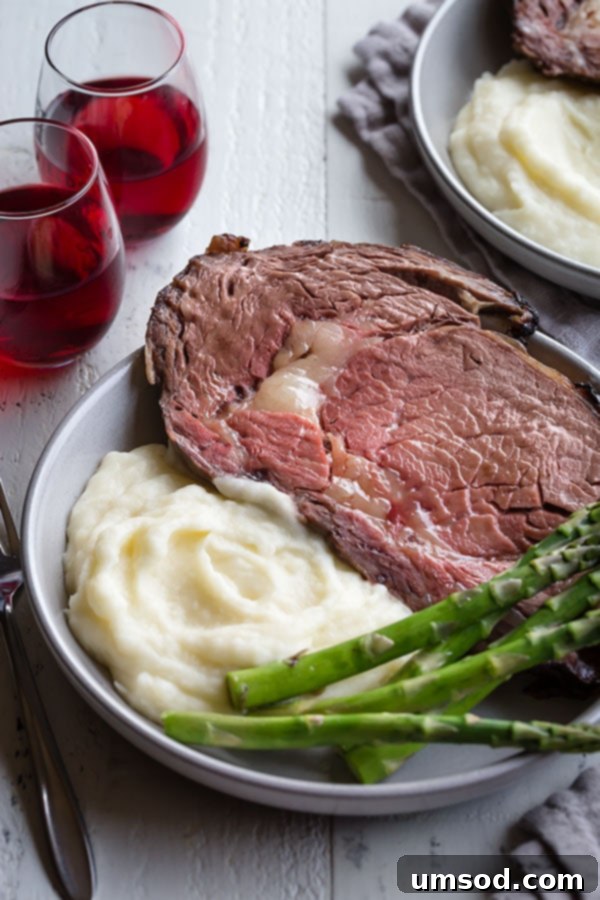
Serving Suggestions: Perfect Pairings for Prime Rib
A magnificent prime rib roast pairs beautifully with a wide array of side dishes, offering versatility to suit any palate or occasion. If you’re seeking inspiration to complement your show-stopping main, here are some of my top recommendations:
- Instant Pot Cheesy Scalloped Potatoes: Rich, creamy, and effortlessly made, these potatoes are a comforting classic.
- Loaded Mashed Potato Casserole: A hearty and flavorful dish packed with cheese, bacon, and chives.
- Quick & Creamy Corn: Sweet and luscious creamed corn provides a perfect contrast to the savory meat.
- Crowd-Pleasing Cheesy Scalloped Potatoes: An indulgent, cheesy side that’s always a hit.
- Warm Quinoa Brussels Sprouts Salad: A lighter, yet satisfying option with wholesome grains and roasted vegetables.
- Classic Green Bean Casserole: A traditional favorite for holiday meals.
- Roasted Asparagus with Lemon: Simple, elegant, and brings a touch of freshness.
- Caesar Salad: A crisp, tangy salad to balance the richness of the roast.
- Horseradish Sauce or Au Jus: Essential for dipping; these sauces enhance the beef’s natural flavors.
Preserving Deliciousness: Storing and Reheating Your Prime Rib
Leftover prime rib is a treat in itself, and with proper storage and reheating techniques, you can enjoy its exquisite flavor and tenderness for days to come:
- Refrigerator Storage: To maintain its quality, store any leftover boneless prime rib tightly wrapped in plastic wrap or placed in an airtight container. It will remain fresh and delicious in the refrigerator for up to 5 days. For optimal moisture and flavor, if possible, leave larger pieces of the roast unsliced and only slice portions just before you plan to serve them.
- Freezer Storage: For longer preservation, leftover prime rib freezes exceptionally well. Wrap individual portions or larger unsliced pieces tightly in plastic wrap, then place them in a freezer-safe bag or container. It can be stored in the freezer for up to 6 months. When you’re ready to enjoy it again, thaw the frozen roast overnight in the refrigerator.
- Gentle Reheating for Best Results: The best method to reheat prime rib without compromising its juiciness is in the oven. Preheat your oven to a low 250°F (120°C). Place the prime rib in a baking dish with a splash of beef broth or water to create steam, then cover the dish tightly with aluminum foil. Roast just until it’s heated through, checking the internal temperature with a thermometer (aim for about 120-130°F for medium-rare to medium). While you can microwave leftovers for convenience, be aware that this method tends to dry out the meat and won’t yield the same juicy, tender results as oven reheating.
Frequently Asked Questions About Prime Rib Roast
How long does it take to cook a boneless prime rib?
The cooking time for a boneless prime rib can vary significantly based on its size, your oven’s accuracy, and your desired doneness. It’s crucial to rely on a meat thermometer rather than just time to prevent overcooking. For example, a 6-pound roast cooked using the reverse searing method (low and slow at 200°F/95°C) typically takes approximately 3.5 to 4 hours to reach an internal temperature of 120°F (49°C) for medium-rare. Achieving a medium doneness (130°F/54°C) will require a slightly longer cooking time.
What’s the difference between prime rib and a rib roast?
Both “prime rib” and “rib roast” refer to cuts of beef from the primal rib section, specifically the 6th through 12th ribs of the cow. Historically, ‘prime rib’ referred to a roast graded ‘USDA Prime,’ but now it’s often used generically for a rib roast. The primary distinction often lies in the bone structure: a ‘prime rib’ is traditionally bone-in, with the bones left intact, offering extra flavor and moisture during cooking. A ‘rib roast’ (or sometimes ‘boneless prime rib’) has the bones removed, making it easier to carve. The boneless version is also frequently cut down into individual ribeye steaks for grilling.
How much prime rib per person should I buy?
A general rule of thumb for boneless prime rib is to plan for about 1/2 pound (approximately 225 grams) of meat per adult serving. However, I always recommend being slightly generous, especially if you want leftovers or have guests with hearty appetites. Adding an extra pound to your total is a good idea, as leftover prime rib is always a welcome bonus! So, if you’re hosting 8 adults for dinner, aim to purchase a 5-pound boneless prime rib. If you opt for a bone-in prime rib, factor in more weight for the bones and plan on roughly 2 people per rib. For bone-in preparation, you can refer to my detailed bone-in prime rib recipe for specific instructions.
What equipment do I need to roast prime rib?
To successfully roast a prime rib, you’ll need a few essential pieces of kitchen equipment. A sturdy roasting pan with a rack is crucial for allowing air circulation around the roast and collecting delicious drippings. A reliable meat thermometer (either an instant-read or a leave-in probe thermometer) is absolutely necessary for monitoring internal temperature and achieving perfect doneness. Other helpful items include a large cutting board with a juice groove, a sharp carving knife, and aluminum foil for resting the roast.
Can I use a bone-in prime rib with the reverse searing method?
Yes, the reverse searing method works beautifully for bone-in prime rib as well! The bones can even add a bit more flavor and help insulate the meat, contributing to a juicier roast. The process remains very similar: dry brining, low and slow roasting to the desired internal temperature, a resting period, and then a final high-heat sear for the crust. You may need to adjust cooking times slightly for a bone-in roast, as the bones conduct heat differently. Always rely on your meat thermometer for accurate results.
Explore More Exquisite Main Courses
If you’ve enjoyed mastering this prime rib, consider broadening your culinary horizons with these other fantastic main course recipes:
- Decadent Roasted Rack of Lamb
- Flavorful Roast Leg of Lamb with Rich Red Wine Gravy
- Secrets to Grilling a Perfect Steak Every Time
- Delicious Stuffed Turkey Breast for Any Occasion
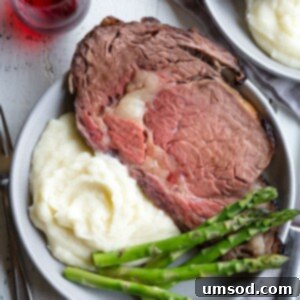
The BEST Boneless Prime Rib Roast
Comment
Print Recipe
Ingredients
- 6 lbs boneless prime rib
- 1 tablespoon coarse kosher salt
- 3 tablespoons olive oil
- 3 tablespoons Montreal steak seasoning
- 3 tablespoons brown sugar
- 2 tablespoons Worcestershire sauce
- 1 tablespoon minced garlic
Instructions
- Place an unwrapped prime rib on a tray. Generously salt all over and refrigerate overnight to air-dry the outside of the prime rib.
- Bring the prime rib to room temperature before roasting. This will take about 2 hours out on the counter.
- Mix olive oil, Montreal steak seasoning, brown sugar, Worcestershire sauce, and minced garlic until smooth. Then evenly spread the mixture all over the roast.
- Preheat the oven to 200°F (95°C).
- Place the prime rib on a roasting pan fat side up. (I use this roaster, and highly recommend it.) Roast the meat in the oven until the center of the roast reads 120°F (49°C) on a meat thermometer for medium-rare, or 130°F (54°C) for medium doneness, about 3.5-4 hours. (This instant thermometer is my favorite! Super quick and reliable!)
- Remove the prime rib from the oven, cover with foil, and rest for about 30 minutes.
- Meanwhile, increase the oven temperature to 500°F (260°C).
- 10 minutes before serving, place the prime rib back into the oven, uncovered, and cook until it’s nice and brown and crisp on the outside, about 6-10 minutes. Rest for 10-15 minutes before slicing and serving.
⭐️ Did you make this recipe?
Please leave a review and let us know how you liked it!
Tips & Notes
Storing Tips:
– Store leftover boneless prime rib wrapped in plastic wrap or in an airtight container in the fridge for up to 5 days. If possible, leave the leftover roast unsliced and slice before you plan to serve it.
– Freeze leftovers wrapped tightly in plastic wrap for up to 6 months. Thaw in the fridge overnight when you’re ready to eat.
– Reheat the roast in the oven to 250°F (120°C). Place the meat in a baking dish with a splash of beef broth, and cover it with foil. Then, roast just until heated through. If you absolutely must, you can microwave leftovers, but they won’t turn out quite as juicy.
Nutrition
Servings: 1 serving (estimated)
Calories: 870 kcal
Carbohydrates: 5 g
Protein: 37 g
Fat: 77 g
Sugar: 4 g
Sodium: 854 mg

Did you make this?
Leave a rating and your feedback. Thank you!
